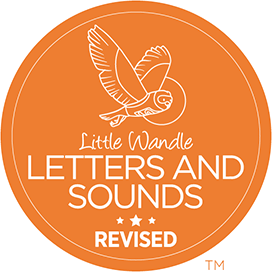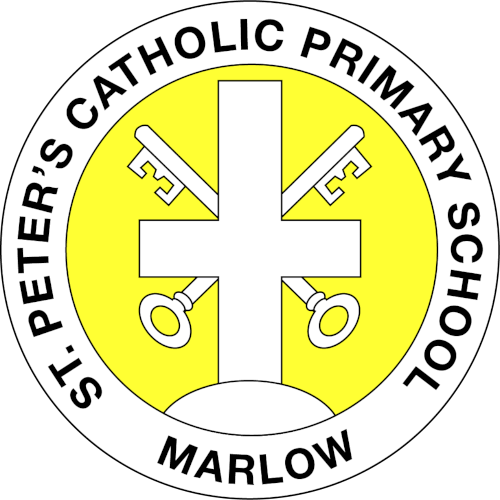Phonics and Early Reading (Little Wandle)
 Teaching Phonics at St Peter’s Catholic Primary School
Teaching Phonics at St Peter’s Catholic Primary School
Since January 2023 we have been using the government validated systematic synthetic phonics programme (SSP) called ‘Little Wandle: Letters & Sounds Revised’. The programme is designed to teach children to read from Reception to Year 2, using the skill of decoding and blending sounds together to form words.
The Little Wandle website (link below) is a fantastic resource to use as parents to help you to feel confident with supporting you child with their phonics at home, as well as providing you with an insight into what their daily phonics sessions in school look like. The ‘For parents' section provides videos of how to pronounce the Phase 2 and Phase 3 sounds which is especially helpful as not all the sounds are pronounced as we would expect. Little Wandle Website
Intent
At St Peter’s Catholic Primary School, we model the application of the alphabetic code through phonics in shared reading and writing, both inside and outside of the phonics lessons and across the curriculum. We have a strong focus on language development for our children because we know that speaking and listening are crucial skills for reading and writing in all subjects.
At St Peter’s Catholic Primary School we value reading as a crucial life skill. By the time children leave us, they read confidently for meaning and regularly enjoy reading for pleasure. Our readers are equipped with the tools to tackle unfamiliar vocabulary. We encourage our children to see themselves as readers for both pleasure and purpose.
We use the government validated systematic synthetic phonics programme (SSP) called ‘Little Wandle: Letters & Sounds Revised’. The programme is designed to teach children to read from Reception to Year 2, using the skill of decoding and blending sounds together to form words. The Little Wandle programme provides a full progression through all commonly occurring GPCs (sounds), working from simple to more complex, and taking into account the frequency of their occurrence in the most commonly encountered words.
The teaching of Phonics is fast-paced, and we encourage all children to actively participate in each lesson; by encouraging the children to take ownership of their learning we are continuously striving for excellence.
At St Peter’s Catholic Primary School we aim to provide all children with the fundamental skills that will enable them to be confident and fluent readers.
Implementation
Reading and writing are essential life skills and we are dedicated to enabling our children to become enthused, engaged and successful lifelong readers and writers. To support this we implement the following:
Daily phonics lessons in Reception and Year 1
We teach phonics for up to 30 minutes a day. In Reception, we build from 10-minute lessons, with additional daily oral blending games, to the full-length lesson as quickly as possible. Every Friday, we review the week’s teaching to help children become fluent readers.
Children make a strong start in Reception: teaching begins in Week 3 of the Autumn term.
We follow the Little Wandle Letters and Sounds Revised expectations of progress:
- Children in Reception are taught to read and spell words using Phase 2 and 3 GPCs, and words with adjacent consonants (Phase 4) with fluency and accuracy.
- Children in Year 1 review Phase 3 and 4 and are taught to read and spell words using Phase 5 GPCs with fluency and accuracy.
- Daily Keep-up lessons ensure every child learns to read
The children are regularly assessed using daily observations in lessons, and more formal assessments every 3-6 weeks depending on their phase. From these assessments, adults can identify children needing further support with their phonics.
Any child who needs additional practice has daily keep-up support, taught by a fully trained adult. Keep-up lessons match the structure of class teaching, and use the same procedures, resources and mantras, but in smaller steps with more repetition, so that every child secures their learning. These sessions ca be 1-1 or small groups.
We timetable additional Phonics lessons for any child in Year 2 who is not fully fluent at reading or has not met the expectation of the Phonics Screening Check in Year 1. These children urgently need to catch up, so the gap between themselves and their peers does not widen. We use the ‘Little Wandle Letters and Sounds Revised’ assessments to identify the gaps in their phonic knowledge and teach to these using the keep-up resources at pace.
Ensuring consistency and pace of progress
· Every teacher in our school has been trained to teach Phonics, the aim throughout the academic year of 2022 – 2023 is to train all staff, with priority given to the TAs who work with children with additional needs, across key stages. This is to ensure we have the same expectations of progress.
· We all use the same language, routines and resources to teach children to read so that we lower children’s cognitive load.
· Weekly content grids map each element of new learning to each day, week and term for the duration of the programme.
· Lesson templates, prompt cards and how to videos ensure teachers all have a consistent approach and structure for each lesson.
· The Reading Leader and SLT use the audit and prompt cards to monitor and observe teaching; they use the summative data to identify children who need additional support and gaps in learning.
Impact
By the time children leave St Peter’s Catholic Primary School they are competent and fluent readers who can recommend books to their peers, have a passion for reading a range of genres including poetry, and participate in discussions about books.
Our systematic approach to teaching Phonics combined with our high expectations has had a positive impact on the reading outcomes for all pupils.
Assessment
Assessment is used to monitor progress and to identify any child needing additional support as soon as they need it.
Assessment for learning is used daily within class to identify children needing keep-up support. Children are assessed weekly in the Review lesson to assess gaps. Adults can address these immediately and secure fluency of GPCs, words and spellings.
Summative assessment
This is used every six weeks to assess progress, to identify gaps in learning that need to be addressed, to identify any children needing additional support and to plan the Keep-up support that they need. These assessments are monitored by SLT and scrutinised through the Little Wandle Letters and Sounds Revised assessment tracker, to narrow attainment gaps between different groups of children and so that any additional support for teachers can be put into place.
Statutory assessment
Children in Year 1 sit the Phonics Screening Check in June. Any child not passing the check re-sits it in Year 2.
Ongoing assessment for catch-up
Children in Year 2 to 6 are assessed through their teacher’s ongoing formative assessment as well as through the half-termly ‘Little Wandle Letters and Sounds Revised’ summative assessments.
 St Peter's Catholic
St Peter's Catholic